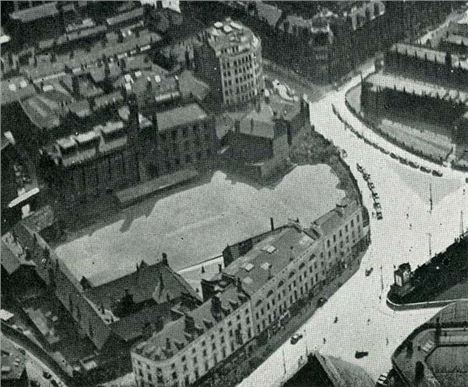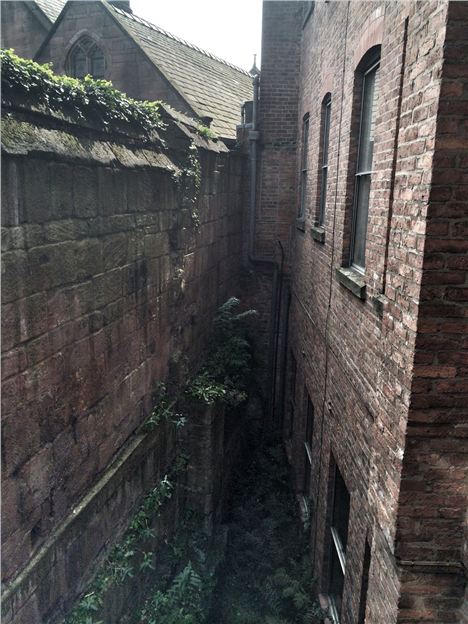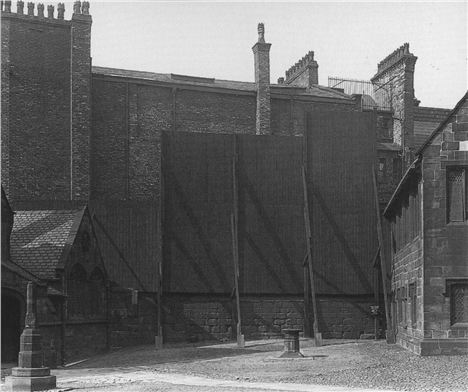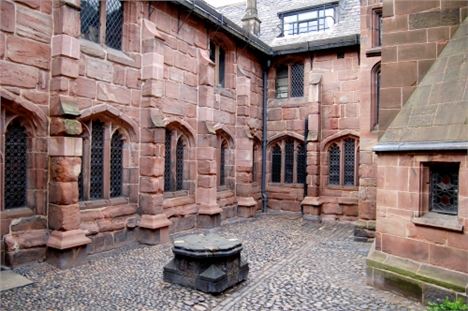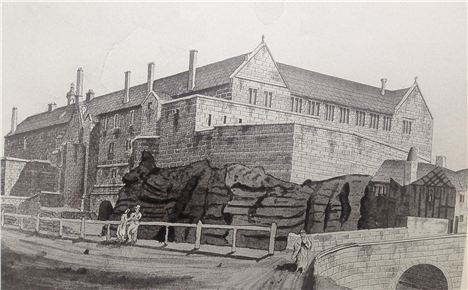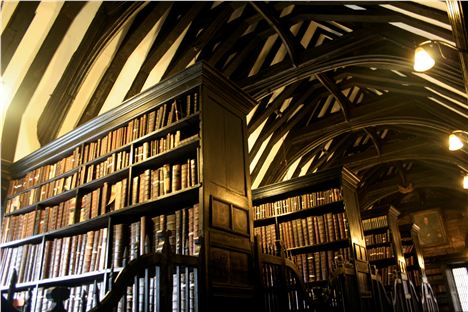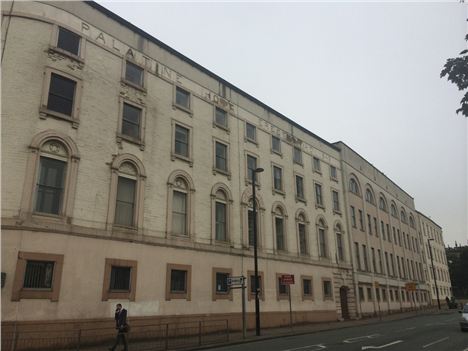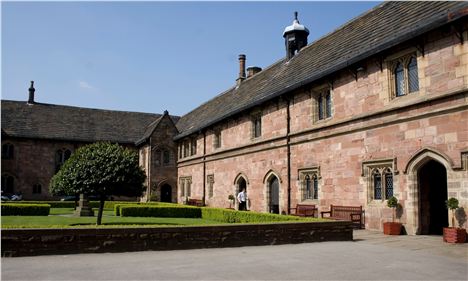This article was originally published on Chetham's Library website (19/09/2014). It explains the need to demolish a large nineteenth century building in the heart of the city so the medieval buildings can be revealed. Confidential whole-heartedly agrees this is desirable for all the reasons explained below. The yellow info box below the article was written by Confidential.
THE Palatine building which stands on the west side of the Chetham’s site was not originally built as one single structure, but was constructed in three distinct parts between 1837-45 by the Manchester and Leeds Railway Company.
These consist of the south building nearest the Cathedral, which operated as livery stables and offices, the middle building, which was offices and shops, and the most significant section, that to the north of the site next to Hunt’s Bank, which was built as a railway hotel. This was designed by J.P. and I. Holden, architects, and constructed in 1842-43 as a railway hotel for the newly opened Victoria Railway Station - one of the earlier hotels of its kind, although not the first.
Chetham's from the air in the first half of the twentieth century showing how the view of the medieval buildings is totally blocked by the tripartite Palatine
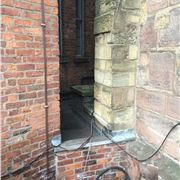 Tight squeezeThe Palatine buildings, then, were not constructed as part of the School and Library and were not part of the site either of Chetham’s or of its predecessor, the College of Manchester. The buildings have not been granted listed status, unlike the medieval buildings to which the Palatine buildings are attached, which are Grade I-listed. Nowadays it would be inconceivable for a building to be placed right up to a Grade I-listed building, but the Palatine building not only runs right up to the medieval building but is physically joined to it at one point, with the sandstone wall embedded within it.
Tight squeezeThe Palatine buildings, then, were not constructed as part of the School and Library and were not part of the site either of Chetham’s or of its predecessor, the College of Manchester. The buildings have not been granted listed status, unlike the medieval buildings to which the Palatine buildings are attached, which are Grade I-listed. Nowadays it would be inconceivable for a building to be placed right up to a Grade I-listed building, but the Palatine building not only runs right up to the medieval building but is physically joined to it at one point, with the sandstone wall embedded within it.
Too close for comfort
Putting a hotel next to a school created problems, and Chetham’s was forced to build enormous wooden hoardings to prevent hotel patrons from overlooking the school. By 1911 the Palatine Hotel had closed for business, and the buildings were converted for retail use. Since then, the buildings have undergone many changes to accommodate a variety of different uses and have been stripped externally and internally of their original architectural features. All the original glazing and all the chimney stacks have been removed.
Blocking the view from hotel to school
The Palatine buildings were acquired by the Trustees of Chetham’s Charity in 1969 and were intended to provide accommodation and school rooms for the newly founded Chetham’s School of Music. They were converted by the architects Thomas Worthington and Son as a temporary refurbishment intended to last no more than ten years.
The buildings were completely unsuitable for their new purpose: they had no sound-proofing and they provided very poor residential space. They were also extraordinarily expensive to maintain. The basements regularly flooded and the roof leaked.
But Chetham’s made use of them not for the ten years they imagined but for over forty years until they were eventually vacated in favour of the new school building, opposite Victoria Station, which opened in 2013. In 2009 Chetham’s trustees put the Palatine buildings up for sale to see if a developer or builder would take them on, but the proposed sale attracted no interest. They are now completely empty and are unsustainable, and are scheduled for demolition in the next twelve months.
The new school building on the right, the older buildings on the left with a corner of Palatine's bare wall peeping out
We recognise that taking down the Palatine buildings is only justified if the results are a significant improvement on what was there before, and in this instance there is no question that the demolition has two huge positive outcomes.
Firstly it opens up what is arguably the most important archaeological site in the city: beneath the Palatine buildings lie the House of Correction, the great tithe barn, the inner ditch and the castle, and some of the lost buildings of the medieval town. Our aim is to ensure that by removing the Palatine buildings we are able to open up the archeology that remains beneath them to the community. We have been in discussions with archaeologists for some time to make sure that these sites are sensitively and appropriately investigated.
Fox Courtyard - one of the most charming spaces in the North of England
Secondly, their removal opens up the medieval College House to Manchester and Salford, a view that has been hidden since the 1840s. We have no wish to open up the site to improve our own view, which will be of a car park, and, if proposed developments take place, two large tower blocks, but we do think that opening up one of Manchester’s very few remaining medieval buildings to public view is important.
By taking down Palatine we are able to open up the medieval College House and the Library as a proper visitor attraction, and we are working in consultation with the City, the Cathedral and architects to put this site to the best possible use.
The view of Chetham's before the Palatine got in the way by John Palmer in 1815
We are currently in the process of making an application for a Heritage Lottery Fund grant to update and improve the medieval buildings as well as to restore and adapt the Grade II-listed nineteenth-century Alfred Waterhouse building which is currently hidden from public view by Palatine.
It is our intention to create new public space as well as improving accessibility to the medieval buildings, and we welcome constructive suggestions for future developments. We are also working with artists-in-residence as well as photography students from Bolton University on a project to properly record the building and document the regeneration of the site.
Inside Chetham's Library
We recognise that the heritage of the site on which Chetham’s stands is of great significance and is valued by many, and it is our full intention to take each decision about its future intelligently and sensitively. Naturally, the loss of an early nineteenth-century railway hotel is regretted by all who have worked in and around it as well as by members of the wider community and those who care about its architectural importance, and we understand that any decisions made regarding its future will have detractors as well as supporters.
Palatine Building and its blank, mucked about with, facade
We are, however, confident not only that all possibilities for the realistic survival of Palatine have been exhausted, but that the decision to demolish it will make way for developments and improvements which will have a very positive effect on this part of the city and all who love and appreciate it.
Chetham’s Library
Chetham's Library is free to visit and is open Mon-Fri, 9am-4.30pm.
Chetham’s Library - and the School of Music linked to it - form the oldest complete structure in the city, dating from the 1420s, when both were erected as a single building to house clergy. After the Reformation, the premises gained a new lease of life when they were purchased through the will of local merchant Humphrey Chetham in 1653. He wished to set up a charity school for 40 poor boys and a free public library for the ‘use of scholars and others well-affected’. Only the library has daily public access. The buildings not only look ancient but feel ancient. You will have to press the bell on the library door to call an attendant. Most of the library fixtures and fittings are original and date from the mid-1600s. The books are shielded behind 18th century gates and were formerly chained to the shelves. Down the side corridor is the main Reading Room with its wonderful carvings. The collection is beautiful and the role call of visitors amazing; Daniel Defoe, Benjamin Franklin, Benjamin Disreali, Winston Churchill. Friedrich Engels and Karl Marx studied together at the bay window in the reading room. This is Manchester’s most charming building.
Long Millgate, M3 1SB. 0161 834 7961. Website
Jonathan Schofield









